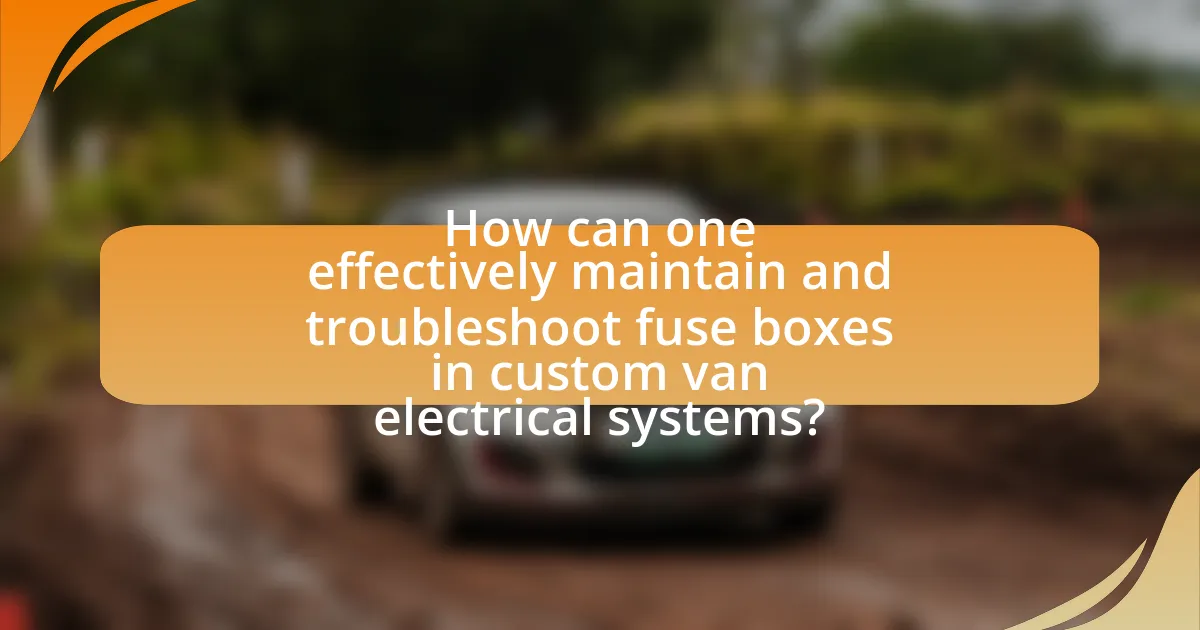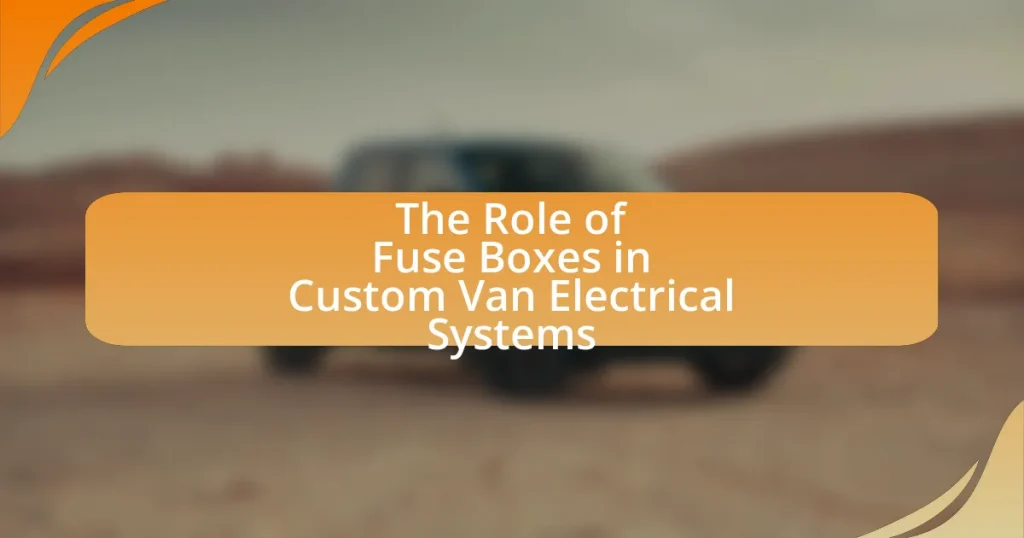Fuse boxes are essential components in custom van electrical systems, providing critical protection against overloads and short circuits. They contain fuses or circuit breakers that interrupt electrical flow during faults, safeguarding wiring and connected devices from damage. The article explores the functionality of fuse boxes, their key components, and the various types available for custom van setups. It also addresses the risks associated with not using a fuse box, the importance of proper amperage ratings, and best practices for installation and maintenance. Additionally, it highlights common issues that may arise and the necessary steps for effective troubleshooting and replacement of faulty fuses.

What is the role of fuse boxes in custom van electrical systems?
Fuse boxes in custom van electrical systems serve as critical safety devices that protect electrical circuits from overloads and short circuits. They contain fuses or circuit breakers that interrupt the flow of electricity when a fault occurs, preventing potential damage to wiring and connected devices. This functionality is essential in custom vans, where multiple electrical components, such as lights, appliances, and charging systems, are integrated. By ensuring that each circuit is safeguarded, fuse boxes help maintain the overall reliability and safety of the electrical system, reducing the risk of fire hazards and equipment failure.
How do fuse boxes function within these electrical systems?
Fuse boxes function as critical components in electrical systems by distributing electrical power to various circuits while providing protection against overloads and short circuits. They contain fuses or circuit breakers that interrupt the flow of electricity when excessive current is detected, preventing potential damage to wiring and connected devices. This protective mechanism is essential for maintaining safety and reliability in custom van electrical systems, where multiple devices may draw power simultaneously. The National Electrical Code (NEC) emphasizes the importance of using properly rated fuses or breakers to ensure that the electrical system operates within safe limits, thereby reinforcing the role of fuse boxes in safeguarding both the electrical infrastructure and the equipment within the van.
What are the key components of a fuse box?
The key components of a fuse box include fuses, bus bars, terminals, and a cover. Fuses protect electrical circuits by breaking the connection when excessive current flows, preventing damage. Bus bars distribute electrical power to various circuits within the fuse box. Terminals serve as connection points for wires, allowing for secure and organized wiring. The cover protects the internal components from dust and accidental contact, ensuring safety and functionality. These components work together to manage and protect the electrical system in custom van setups.
How does a fuse box protect electrical circuits?
A fuse box protects electrical circuits by containing fuses that interrupt the flow of electricity when a fault occurs, preventing damage to the wiring and connected devices. When excessive current flows through a circuit, the fuse element melts, breaking the circuit and stopping the flow of electricity. This mechanism is crucial for preventing overheating, electrical fires, and equipment damage, as it ensures that only the affected circuit is disconnected while others remain operational. The National Fire Protection Association (NFPA) reports that proper use of fuses and circuit breakers significantly reduces the risk of electrical fires, highlighting the importance of fuse boxes in maintaining electrical safety.
Why are fuse boxes essential for custom van electrical systems?
Fuse boxes are essential for custom van electrical systems because they provide a centralized location for circuit protection and management. They safeguard electrical components by containing fuses or circuit breakers that prevent overloads and short circuits, which can lead to fires or equipment damage. The use of fuse boxes ensures that each circuit can be independently monitored and controlled, enhancing safety and reliability in the electrical system. Additionally, they facilitate easier troubleshooting and maintenance, as issues can be quickly identified and isolated without affecting the entire system.
What risks are associated with not using a fuse box?
Not using a fuse box poses significant risks, including electrical fires, equipment damage, and safety hazards. Without a fuse box, there is no mechanism to interrupt the electrical flow in case of overloads or short circuits, which can lead to overheating and potential ignition of surrounding materials. Additionally, sensitive electronic devices may suffer from voltage spikes, resulting in costly repairs or replacements. The National Fire Protection Association reports that electrical failures or malfunctions are a leading cause of home fires, underscoring the critical role of fuse boxes in preventing such incidents.
How do fuse boxes enhance safety and reliability?
Fuse boxes enhance safety and reliability by providing a centralized location for circuit protection and management. They contain fuses or circuit breakers that automatically disconnect electrical circuits in the event of overloads or short circuits, preventing potential fires and equipment damage. For instance, the National Fire Protection Association (NFPA) reports that electrical failures are a leading cause of home fires, and proper fuse box installation significantly reduces this risk. Additionally, fuse boxes allow for organized wiring, making it easier to identify and address electrical issues, thus improving overall system reliability.

What types of fuse boxes are available for custom van electrical systems?
There are several types of fuse boxes available for custom van electrical systems, including blade fuse boxes, glass fuse boxes, and circuit breaker panels. Blade fuse boxes are commonly used due to their compact size and ease of installation, making them suitable for various applications in vans. Glass fuse boxes, while less common, offer a traditional option that can be useful for specific vintage or aesthetic preferences. Circuit breaker panels provide a more advanced solution, allowing for easy reset of circuits and enhanced safety features. These options cater to different needs and preferences in custom van electrical setups, ensuring that users can select the most appropriate system for their requirements.
How do different fuse box designs cater to various electrical needs?
Different fuse box designs cater to various electrical needs by providing tailored configurations for circuit management, load distribution, and safety features. For instance, modular fuse boxes allow for easy expansion and customization, accommodating additional circuits as electrical demands increase, which is essential in custom van electrical systems where power requirements can vary significantly. Additionally, some designs incorporate specific features like blade fuses for high-current applications or mini fuses for compact spaces, ensuring that the fuse box can handle the unique load characteristics of different devices. This adaptability is crucial for optimizing performance and safety in diverse electrical setups, as evidenced by the increasing use of smart fuse boxes that offer monitoring capabilities to track power usage and detect faults in real-time.
What are the differences between blade fuses and glass fuses?
Blade fuses and glass fuses differ primarily in their design and application. Blade fuses feature a plastic body with two metal prongs that insert into a fuse box, making them easy to replace and widely used in automotive and marine applications. In contrast, glass fuses consist of a glass tube with metal end caps, which can be more fragile and are typically found in older electrical systems or household appliances. The blade fuse’s design allows for better heat dissipation and a more compact form factor, while glass fuses provide visual confirmation of a blown fuse due to the visible filament inside.
Which fuse box configurations are most popular among van builders?
The most popular fuse box configurations among van builders are the 12V blade fuse boxes and the 12V mini blade fuse boxes. These configurations are favored due to their compact size, ease of installation, and ability to accommodate multiple circuits efficiently. The 12V blade fuse box typically supports a range of 6 to 12 circuits, making it suitable for various electrical setups in vans, while the mini blade fuse box offers a similar functionality in a smaller footprint, ideal for tight spaces. The widespread use of these configurations is supported by their compatibility with standard automotive fuses, which are readily available and easy to replace, ensuring reliability and convenience for van builders.
What factors should be considered when selecting a fuse box?
When selecting a fuse box, key factors include the electrical load capacity, the number of circuits required, and the type of fuses compatible with the system. The electrical load capacity must match or exceed the total amperage of the devices being powered to prevent overloads. The number of circuits is essential for organizing and protecting various electrical components, ensuring that each circuit can handle the specific load without risk of failure. Additionally, compatibility with the appropriate fuse types, such as blade fuses or cartridge fuses, is crucial for effective operation and safety. These considerations ensure that the fuse box functions efficiently within the custom van electrical system, providing reliable protection against electrical faults.
How does the size of the fuse box impact installation?
The size of the fuse box directly impacts installation by determining the number of circuits it can accommodate and the overall space required for mounting. A larger fuse box allows for more circuits, which is essential for complex electrical systems in custom vans that may require multiple appliances and devices. Additionally, a bigger fuse box necessitates more physical space for installation, which can be a limiting factor in compact van designs. Proper sizing ensures that the electrical system is organized and can handle the load without risk of overheating or failure, as supported by electrical code requirements that dictate the minimum size based on the number of circuits and amperage.
What is the importance of amperage ratings in fuse selection?
Amperage ratings are crucial in fuse selection because they determine the maximum current a fuse can safely carry before it blows. Selecting a fuse with the correct amperage rating ensures that it will protect the electrical circuit from overloads and prevent potential damage to wiring and connected devices. For instance, if a circuit is rated for 15 amps, using a fuse with a higher rating, such as 20 amps, could allow excessive current to flow, leading to overheating and fire hazards. Therefore, adhering to the appropriate amperage rating is essential for maintaining safety and functionality in electrical systems, particularly in custom van setups where reliable performance is critical.

How can one effectively maintain and troubleshoot fuse boxes in custom van electrical systems?
To effectively maintain and troubleshoot fuse boxes in custom van electrical systems, one should regularly inspect the fuse box for signs of wear, corrosion, or damage, and replace any blown fuses with the correct amperage rating. Regular inspections help identify potential issues before they escalate, ensuring the electrical system operates smoothly. Additionally, using a multimeter to test for continuity and voltage can help diagnose problems within the fuse box, confirming whether the fuses are functioning correctly. Proper labeling of fuses and circuits enhances troubleshooting efficiency, allowing for quick identification of issues. These practices are supported by the fact that regular maintenance can prevent electrical failures, which are a common cause of breakdowns in custom van systems.
What are common issues that arise with fuse boxes?
Common issues that arise with fuse boxes include blown fuses, corrosion, and loose connections. Blown fuses occur when the electrical load exceeds the fuse’s rating, leading to interruptions in power supply. Corrosion can develop over time due to moisture exposure, which compromises the electrical connections and can cause malfunction. Loose connections may result from vibrations or improper installation, leading to intermittent power issues. These problems can significantly affect the performance of electrical systems in custom van setups, making regular maintenance essential for reliability.
How can one identify a blown fuse in a fuse box?
To identify a blown fuse in a fuse box, visually inspect the fuse for a broken metal filament or discoloration. A blown fuse typically shows a gap in the filament or a darkened appearance, indicating that it has failed. Additionally, using a multimeter to test continuity can confirm if the fuse is operational; a lack of continuity indicates a blown fuse. This method is reliable as it directly assesses the electrical pathway through the fuse, providing a definitive check on its functionality.
What steps should be taken to replace a faulty fuse?
To replace a faulty fuse, first, ensure the power supply to the fuse box is turned off to prevent electrical shock. Next, locate the faulty fuse by checking the fuse box diagram or inspecting the fuses visually for any signs of damage, such as a broken filament or discoloration. Once identified, carefully remove the faulty fuse by pulling it straight out of its socket. Then, select a new fuse that matches the amperage rating of the old fuse, which is usually indicated on the fuse itself or in the fuse box diagram. Finally, insert the new fuse into the socket firmly and restore power to the fuse box to test if the electrical circuit is functioning properly.
What best practices should be followed for fuse box installation and maintenance?
Best practices for fuse box installation and maintenance include ensuring proper sizing and placement, using high-quality components, and adhering to local electrical codes. Proper sizing involves selecting a fuse box that can handle the total load of the electrical system, which prevents overheating and potential fire hazards. Placement should be in a dry, accessible location to facilitate maintenance and avoid moisture damage. Using high-quality components, such as fuses and connectors, enhances reliability and safety. Adhering to local electrical codes ensures compliance with safety standards, reducing the risk of electrical failures. Regular maintenance, including inspecting for corrosion, ensuring tight connections, and replacing blown fuses promptly, is essential for optimal performance and safety.
How can proper wiring techniques prevent fuse box issues?
Proper wiring techniques can prevent fuse box issues by ensuring that electrical connections are secure, correctly rated, and free from damage. When wires are properly insulated and routed, the risk of short circuits, overheating, and electrical arcing is significantly reduced. For example, using the appropriate gauge wire for the load prevents overheating, which can lead to fuse failure. Additionally, maintaining organized wiring reduces the likelihood of accidental disconnections or wear over time. According to the National Electrical Code, following proper wiring practices is essential for safety and reliability in electrical systems, thereby minimizing potential fuse box malfunctions.
What routine checks should be performed on fuse boxes?
Routine checks on fuse boxes should include inspecting for signs of damage, ensuring all fuses are properly seated, and testing the functionality of each fuse. Regular visual inspections can reveal issues such as burn marks, corrosion, or loose connections, which indicate potential electrical hazards. Additionally, verifying that fuses are rated correctly for their respective circuits ensures safety and prevents overloads. Testing fuses with a multimeter confirms their operational status, providing assurance that the electrical system is functioning correctly. These checks are essential for maintaining the integrity and safety of custom van electrical systems.



